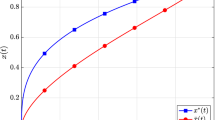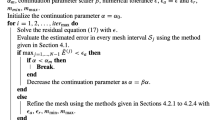Abstract
A method is developed for solving bang-bang and singular optimal control problems using adaptive Legendre–Gauss–Radau collocation. The method is divided into several parts. First, a structure detection method is developed that identifies switch times in the control and analyzes the corresponding switching function for segments where the solution is either bang-bang or singular. Second, after the structure has been detected, the domain is decomposed into multiple domains such that the multiple-domain formulation includes additional decision variables that represent the switch times in the optimal control. In domains classified as bang-bang, the control is set to either its upper or lower limit. In domains identified as singular, the objective function is augmented with a regularization term to avoid the singular arc. An iterative procedure is then developed for singular domains to obtain a control that lies in close proximity to the singular control. The method is demonstrated on four examples, three of which have either a bang-bang and/or singular optimal control while the fourth has a smooth and nonsingular optimal control. The results demonstrate that the method of this paper provides accurate solutions to problems whose solutions are either bang-bang or singular when compared against previously developed mesh refinement methods that are not tailored for solving nonsmooth and/or singular optimal control problems, and produces results that are equivalent to those obtained using previously developed mesh refinement methods for optimal control problems whose solutions are smooth.






Similar content being viewed by others
Data Availability Statement
The data that support the findings of this study are available from the corresponding author upon request.
References
Betts, J.T.: Practical Methods for Optimal Control and Estimation Using Nonlinear Programming. SIAM, New York (2010)
Gill, P.E., Murray, W., Saunders, M.A.: SNOPT: an SQP algorithm for large-scale constrained optimization. SIAM Rev. 47(1), 99–131 (2002). https://doi.org/10.1137/S0036144504446096
Biegler, L.T., Zavala, V.M.: Large-scale nonlinear programming using IPOPT: an integrating framework for enterprise-wide optimization. Comput. Chem. Eng. 33(3), 575–582 (2008). https://doi.org/10.1016/j.compchemeng.2008.08.006
Benson, D.A., Huntington, G.T., Thorvaldsen, T.P., Rao, A.V.: Direct trajectory optimization and costate estimation via an orthogonal collocation method. J. Guid. Control. Dyn. 29(6), 1435–1440 (2006). https://doi.org/10.2514/1.20478
Garg, D., Patterson, M.A., Hager, W.W., Rao, A.V., Benson, D.A., Huntington, G.T.: A unified framework for the numerical solution of optimal control problems using pseudospectral methods. Automatica 46(11), 1843–1851 (2010). https://doi.org/10.1016/j.automatica.2010.06.048
Garg, D., Hager, W.W., Rao, A.V.: Pseudospectral methods for solving infinite-horizon optimal control problems. Automatica 47(4), 829–837 (2011). https://doi.org/10.1016/j.automatica.2011.01.085
Garg, D., Patterson, M.A., Darby, C.L., Francolin, C., Huntington, G.T., Hager, W.W., Rao, A.V.: Direct trajectory optimization and costate estimation of finite-horizon and infinite-horizon optimal control problems via a radau pseudospectral method. Comput. Optim. Appl. 49(2), 335–358 (2011). https://doi.org/10.1007/s10589-009-9291-0
Rao, A.V., Benson, D.A., Darby, C.L., Francolin, C., Patterson, M.A., Sanders, I., Huntington, G.T.: Algorithm 902: GPOPS. A MATLAB software for solving multiple-phase optimal control problems using the gauss pseudospectral method. ACM Trans. Math. Software 37(2) (2010). https://doi.org/10.1145/1731022.1731032
Kameswaran, S., Biegler, L.T.: Convergence rates for direct transcription of optimal control problems using collocation at Radau points. Comput. Optim. Appl. 41(1), 81–126 (2008). https://doi.org/10.1007/s10589-007-9098-9
Patterson, M.A., Hager, W.W., Rao, A.V.: A \(ph\) mesh refinement method for optimal control. Opt. Control Appl. Methods 36(4), 398–421 (2015). https://doi.org/10.1002/oca.2114
Elnagar, G., Kazemi, M.A., Razzaghi, M.: The pseudospectral legendre method for discretizing optimal control problems. IEEE Trans. Autom. Control 40(10), 1793–1796 (1995). https://doi.org/10.1109/9.467672
Hager, W.W., Hou, H., Rao, A.V.: Convergence rate for a gauss collocation method applied to unconstrained optimal control. J. Optim. Theory Appl. 169(3), 801–824 (2016). https://doi.org/10.1007/s10957-016-0929-7
Hager, W.W., Hou, H., Rao, A.V.: Lebesgue constants arising in a class of collocation methods. IMA J. Numer. Anal. 37(4), 1884–1901 (2017). https://doi.org/10.1093/imanum/drw060
Hager, W.W., Liu, J., Mohapatra, S., Rao, A.V., Wang, X.-S.: Convergence rate for a Gauss collocation method applied to constrained optimal control. SIAM J. Control. Optim. 56, 1386–1411 (2018). https://doi.org/10.1137/16M1096761
Hager, W.W., Hou, H., Mohapatra, S., Rao, A.V., Wang, X.-S.: Convergence rate for a Radau hp-collocation method applied to constrained optimal control. Comput. Optim. Appl. 74, 274–314 (2019). https://doi.org/10.1007/s10589-019-00100-1
Liu, F., Hager, W.W., Rao, A.V.: Adaptive mesh refinement method for optimal control using nonsmoothness detection and mesh size reduction. J. Franklin Inst. 352(10), 4081–4106 (2015). https://doi.org/10.1016/j.jfranklin.2015.05.028
Gong, Q., Fahroo, F., Ross, I.M.: Spectral algorithm for pseudospectral methods in optimal control. J. Guid. Control. Dyn. 31(3), 460–471 (2008). https://doi.org/10.2514/1.32908
Miller, A.T., Hager, W.W., Rao, A.V.: Mesh refinement method for solving optimal control problems with nonsmooth solutions using jump function approximations. Opt. Control Appl. Methods (2021). https://doi.org/10.1002/oca.2719
Schlegel, M., Marquardt, W.: Direct sequential dynamic optimization with automatic switching structure detection. IFAC Proc. Vol. 37(9), 419–424 (2004). https://doi.org/10.1016/s1474-6670(17)31845-1
Schlegel, M., Marquardt, W.: Detection and exploitation of the control switching structure in the solution of dynamic optimization problems. J. Process Control 16(3), 275–290 (2006). https://doi.org/10.1016/j.jprocont.2005.06.008
Wang, P., Yang, C., Yuan, Z.: The combination of adaptive pseudospectral method and structure detection procedure for solving dynamic optimization problems with discontinuous control profiles. Ind. Eng. Chem. Res. 53(17), 7066–7078 (2014). https://doi.org/10.1021/ie404148j
Chen, W., Biegler, L.T.: Nested direct transcription optimization for singular optimal control problems. AIChE J. 62(10), 3611–3627 (2016). https://doi.org/10.1002/aic.15272
Chen, W., Ren, Y., Zhang, G., Biegler, L.T.: A simultaneous approach for singular optimal control based on partial moving grid. AIChE J. 65(6), e16584 (2019). https://doi.org/10.1002/aic.16584
Darby, C.L., Hager, W.W., Rao, A.V.: An hp-adaptive pseudospectral method for solving optimal control problems. Opt. Control Appl. Methods 32(4), 476–502 (2010). https://doi.org/10.1002/oca.957
Liu, F., Hager, W.W., Rao, A.V.: Adaptive mesh refinement method for optimal control using decay rates of legendre polynomial coefficients. IEEE Trans. Control Syst. Technol. 26(4), 1475–1483 (2018). https://doi.org/10.1109/tcst.2017.2702122
Agamawi, Y.M., Hager, W.W., Rao, A.V.: Mesh refinement method for solving bang-bang optimal control problems using direct collocation. AIAA Scitech 2020 Forum 0378 (2020). https://doi.org/10.2514/6.2017-1506
Aghaee, M., Hager, W.W.: The switch point algorithm. SIAM J. Control. Optim. 59(4), 2570–2593 (2021)
Kaya, C., Noakes, J.: Computational method for time-optimal switching control. J. Optim. Theory Appl. 117(1), 69–92 (2003). https://doi.org/10.1023/a:1023600422807
Mehrpouya, M.A., Khaksar-e Oshagh, M.: An efficient numerical solution for time switching optimal control problems. Comput.l Methods Differ. Equ. 9(1) (2021). https://doi.org/10.22034/cmde.2020.33529.1542
Aronna, M.S., Bonnans, J.F., Martinon, P.: A shooting algorithm for optimal control problems with singular Arcs. J. Optim. Theory Appl. 158(2), 419–459 (2013). https://doi.org/10.1007/s10957-012-0254-8
Mehra, R., Davis, R.: A generalized gradient method for optimal control problems with inequality constraints and singular arcs. IEEE Trans. Autom. Control 17(1), 69–79 (1972). https://doi.org/10.1109/tac.1972.1099881
Jacobson, D., Gershwin, S., Lele, M.: Computation of optimal singular controls. IEEE Trans. Autom. Control 15(1), 67–73 (1970). https://doi.org/10.1109/tac.1970.1099360
Maurer, H.: Numerical solution of singular control problems using multiple shooting techniques. J. Optim. Theory Appl. 18(2), 235–257 (1976). https://doi.org/10.1007/bf00935706
Andrés-Martínez, O., Flores-Tlacuahuac, A., Kameswaran, S., Biegler, L.T.: An efficient direct/indirect transcription approach for singular optimal control. AIChE J. 65(3), 937–946 (2018). https://doi.org/10.1002/aic.16487
Caponigro, M., Ghezzi, R., Piccoli, B., Trélat, E.: Regularization of chattering phenomena via bounded variation controls. IEEE Trans. Autom. Control 63(7), 2046–2060 (2018). https://doi.org/10.1109/TAC.2018.2810540
Mall, K., Grant, M.J., Taheri, E.: Uniform trigonometrization method for optimal control problems with control and state constraints. J. Spacecr. Rocket. 57(5), 995–1007 (2020). https://doi.org/10.2514/1.a34624
Fabien, B.C.: Indirect solution of inequality constrained and singular optimal control problems via a simple continuation method. J. Dyn. Syst. Meas. Contr. 136(2), 021003 (2013). https://doi.org/10.1115/1.4025596
Andrés-Martínez, O., Biegler, L.T., Flores-Tlacuahuac, A.: An indirect approach for singular optimal control problems. Comput. Chem. Eng. 139, (2020). https://doi.org/10.1016/j.compchemeng.2020.106923
Maga, L., Reverberi, A., et al.: A pattern recognition approach to the solution of optimal singular control problems. Chem. Eng. J. 68(1), 35–40 (1997). https://doi.org/10.1016/S1385-8947(97)00068-5
Athans, M., Falb, P.L.: Optimal Control: An Introduction to the Theory and Its Applications. Courier Corporation, North Chelmsford (2013)
Kirk, D.E.: Optimal Control Theory: An Introduction. Courier Corporation, North Chelmsford (2004)
Bryson, A.E., Ho, Y.: Applied Optimal Control: Optimization, Estimation, and Control. Hemisphere Publishing Corporation, London (1975)
Schättler, H., Ledzewicz, U.: Geometric Optimal Control: Theory, Methods and Examples, vol. 38. Springer, Berlin (2012)
Kelley, H., Kopp, R.E., Moyer, H.G.: Topics in Optimization, edited by Leitman (1967)
Kopp, R.E., Moyer, H.G.: Necessary conditions for singular extremals. AIAA J. 3(8), 1439–1444 (1965). https://doi.org/10.2514/3.3165
Archibald, R., Gelb, A., Yoon, J.: Polynomial fitting for edge detection in irregularly sampled signals and images. SIAM J. Numer. Anal. 43(1), 259–279 (2005). https://doi.org/10.1137/s0036142903435259
Fritsch, F.N., Carlson, R.E.: Monotone piecewise cubic interpolation. SIAM J. Numer. Anal. 17(2), 238–246 (1980). https://doi.org/10.1137/0717021
Patterson, M.A., Rao, A.V.: GPOPS-II. ACM Trans. Math. Software 41(1), 1–37 (2014). https://doi.org/10.1145/2558904
Weinstein, M.J., Rao, A.V.: Algorithm 984: ADiGator, a toolbox for the algorithmic differentiation of mathematical functions in MATLAB using source transformation via operator overloading. ACM Trans. Math. Software 44(2), 1–25 (2017). https://doi.org/10.1145/3104990
Dolan, E.D., More, J.J., Munson, T.S.: Benchmarking optimization software with COPS 3.0. Tech. rep., Argonne National Laboratory, Argonne, Illinois (2004). https://doi.org/10.2172/834714
Acknowledgements
The authors gratefully acknowledge support for this research from the U.S. National Science Foundation under grants DMS-1819002 and CMMI-2031213, the U.S. Office of Naval Research under grant N00014-19-1-2543, and from Lockheed-Martin Corporation under contract 4104177872.
Author information
Authors and Affiliations
Corresponding author
Additional information
Publisher's Note
Springer Nature remains neutral with regard to jurisdictional claims in published maps and institutional affiliations.
Rights and permissions
About this article
Cite this article
Pager, E.R., Rao, A.V. Method for solving bang-bang and singular optimal control problems using adaptive Radau collocation. Comput Optim Appl 81, 857–887 (2022). https://doi.org/10.1007/s10589-022-00350-6
Received:
Accepted:
Published:
Issue Date:
DOI: https://doi.org/10.1007/s10589-022-00350-6




